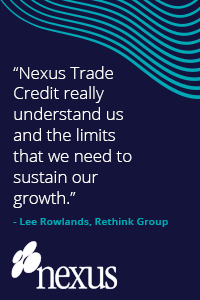 Although global uncertainty remains as we enter 2023, one uncontroversial statement is that we are likely already in a recession in the UK.
Although global uncertainty remains as we enter 2023, one uncontroversial statement is that we are likely already in a recession in the UK.
As insurers it is our job to pick the winners and losers from the downturn: supporting those viable business who are going through macro or sector-induced pressures, and steering clients away from those risks where the alarm bells are sounding.
The last few years have taught us to expect the unexpected, but we highlight three key areas of risk we will be focusing on over the coming months: Debt, Inflation Effects and Changing Sector Structures.
Debt
A key risk of higher interest rates will be on leveraged businesses. Although lending appetite from the main banks remains sound at the end of 2022, there are lots of bond/structured debt holders with high stakes in businesses under increasing pressure. As well as principals needing to be refinanced, it is very likely that covenants could start to be breached, testing the goodwill of funders.
In 2008 we saw a raft of debt for equity swaps to save liquidity-starved businesses. 2023 could see the return of takeovers of highly leveraged businesses by their funders. Iceland Foods, Wilko and Matalan have all been in the press of late: other leveraged companies such Asos.com have seen their share price fall as they face trading headwinds. The question for credit insurers and suppliers is how this process will work — will stakeholders support businesses or look for unsecured creditors to take a writedown on debts due? Will CVAs return to the mainstream?
On a more micro-level, if working capital facilities become more expensive then the incentive is there to push out a cheaper form of finance, i.e. trade creditors. Although it might not necessarily be a sign of company weakness, increased exposures implies higher risk levels for those debtors that are in cash flow trouble.
Inflation Effects
Rising prices will continue to be a major risk for the foreseeable, but the implication will vary by sector.
On one end of the scale is the food sector where inflation continues to run extremely hot — over 15% as of November — but with limited ability to pass this on through the supermarkets and to the consumer. The issue for manufacturers will be squeezed margins.
Further through the cycle is primary commodities. Some input costs are starting to fall back: timber prices have been on the decline since July, metals prices are following a similar path, global shipping costs are down some two-thirds compared to early 2022. As a wider global slowdown is felt it is conceivable raw material prices will continue to fall back over the coming year.
Implications of this depend on where a company sits in the supply chain. It is, of course, good news for manufacturers: cost of goods sold and transportation should both come down. However, distributors/merchants that have seen a boom to their top line from higher prices could see pressure on bottom lines and cash flows as inflation eases. Over-stocking could easily rear its head in H1.
Changing Sector Structures
Even before covid the retail landscape could probably be summed up as ‘Online = Good: Bricks and Mortar = Bad’. However, this will be the first time that a number of key online retailers have faced a slowdown in consumer spending of this size and it remains to be seen how they will cope. Already mentioned above is Asos, whilst we saw the failures of Missguided and Made.com in 2022.
Valuations around ‘speedy grocery’ providers such as the recently-merged Gorillas and Getir have contracted sharply from 2021. Deliveroo shares are currently running at about 25% of 2021-highs.Internet retail is not perhaps the safe-bet unicorn previously thought.
Reason for Optimism?
Although there remains plenty of risk, there are also reasons for cautious optimism. Firstly, we are two years past Brexit and exporters are starting to get used to the requirements of trade with the continent. It is early days still but there are tentative steps of a better co-operation between the UK and eurozone.
Secondly, energy prices — particularly gas — have not held up at H1 2022 levels. The price of petrol at the pump has not got back to the highs of the summer. Furthermore, the move to a greener agenda is seeing more positive noise around investment in the North Sea. The world’s largest offshore wind farm was opened off the UK coast in September, and this is soon set to be overtaken by the Dogger Bank project which started construction last spring. Opportunities are there for the supply chain.
Lastly, and something we sometimes overlook, is how far we have come from the lows of lockdown. Even 12 months ago we were still being encouraged to work from home ‘where possible’. Opportunities from being able to do business face-to-face contact should not be underestimated, nor should they be taken for granted!
All news stories on Credit Insurance News' website are included with the prior permission of the copyright holder. Reproduction or redistribution in whole or in part, in any manner, without the express prior written consent of the copyright holder, is a violation of copyright law. If you, or your organisation wish to redistribute, republish or link-to all or any part of any Credit Insurance News Digest, you must first contact the copyright holder direct or email sally.brown@creditinsurancenews.co.uk for further information.

